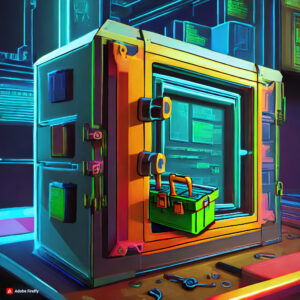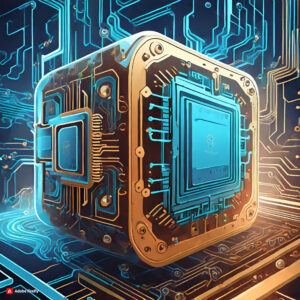I have not been so active for a while with writing these Fedora Workstation updates and part of the reason was that I felt I was beginning to repeat myself a lot, which I partly felt was a side effect of writing them so often, but with some time now since my last update I felt that time was ripe again. So what are some of the things we have been working on and what are our main targets going forward? This is not a exhaustive list, but hopefully items you find interesting. Apologize for weird sentences and potential spelling mistakes, but it ended up a a long post and when you read your own words over for the Nth time you start going blind to issues :)
PipeWire
 PipeWire keeps the Linux Multimedia revolution rolling[/caption]So lets start with one of your favorite topics, PipeWire. As you probably know PipeWire 1.0 is now out and I feel it is a project we definitely succeeded with, so big kudos to Wim Taymans for leading this effort. I think the fact that we got both the creator of JACK, Paul Davis and the creator of PulseAudio Lennart Poettering to endorse it means our goal of unifying the Linux audio landscape is being met. I include their endorsement comments from the PipeWire 1.0 release announcement here :
PipeWire keeps the Linux Multimedia revolution rolling[/caption]So lets start with one of your favorite topics, PipeWire. As you probably know PipeWire 1.0 is now out and I feel it is a project we definitely succeeded with, so big kudos to Wim Taymans for leading this effort. I think the fact that we got both the creator of JACK, Paul Davis and the creator of PulseAudio Lennart Poettering to endorse it means our goal of unifying the Linux audio landscape is being met. I include their endorsement comments from the PipeWire 1.0 release announcement here :
“PipeWire represents the next evolution of audio handling for Linux, taking
the best of both pro-audio (JACK) and desktop audio servers (PulseAudio) and
linking them into a single, seamless, powerful new system.”
– Paul Davis, JACK and Ardour author
“PipeWire is a worthy successor to PulseAudio, providing a feature set
closer to how modern audio hardware works, and with a security model
with today’s application concepts in mind. Version 1.0 marks a
major milestone in completing the adoption of PipeWire in the standard
set of Linux subsystems. Congratulations to the team!”
– Lennart Poettering, Pulseaudio and systemd author
So for new readers, PipeWire is a audio and video server we created for Fedora Workstation to replace PulseAudio for consumer audio, JACK for pro-audio and add similar functionality for video to your linux operating system. So instead of having to deal with two different sound server architectures users now just have to deal with one and at the same time they get the same advantages for video handling. Since PipeWire implemented both the PulseAudio API and the JACK API it is a drop in replacement for both of them without needing any changes to the audio applications built for those two sound servers. Wim Taymans alongside the amazing community that has grown around the project has been hard at work maturing PipeWire and adding any missing feature they could find that blocked anyone from moving to it from either PulseAudio and JACK. Wims personal focus recently has been on an IRQ based ALSA driver for PipeWire to be able to provide 100% performance parity with the old JACK server. So while a lot of Pro-audio users felt that PipeWire’s latency was already good enough, this work by Wim shaves of the last few milliseconds to reach the same level of latency as JACK itself had.
In parallel with the work on PipeWire the community and especially Collabora has been hard at work on the new 0.5 release of WirePlumber, the session manager which handles all policy issues for PipeWire. I know people often get a little confused about PipeWire vs WirePlumber, but think of it like this: PipeWire provides you the ability to output audio through a connected speaker, through a bluetooth headset, through an HDMI connection and so on, but it doesn’t provide any ‘smarts’ for how that happens. The smarts are instead provided by WirePlumber which then contains policies to decide where to route your audio or video, either based on user choice or through preset policies making the right choices automatically, like if you disconnect your USB speaker it will move the audio to your internal speaker instead. Anyway, WirePlumber 0.5 will be a major step forward for WirePlumber moving from using lua scripts for configuration to instead using JSON for configuration while retaining lua for scripting. This has many advantages, but I point you to this excellent blog post by Collabora’s Ashok Sidipotu for the details. Ashok got further details about WirePlumber 0.5 that you can find here.
With PipeWire 1.0 out the door I feel we are very close to reaching one of our initial goals with PipeWire, to remove the need for custom pro-audio distributions like Fedora JAM or Ubuntu Studio, and instead just let audio folks be able to use the same great Fedora Workstation as the rest of the world. With 1.0 done Wim plans next to look a bit at things like configuration tools and similar used by pro-audio folks and also dive into the Flatpak portal needs of pro-audio applications more, to ensure that Flatpaks + PipeWire is the future of pro-audio.
On the video handling side its been a little slow going since there applications need to be ported from relying directly on v4l. Jan Grulich has been working with our friends at Mozilla and Google to get PipeWire camera handling support into Firefox and Google Chrome. At the moment it looks like the Firefox support will land first, in fact Jan has set up a COPR that lets you try it out here. For tracking the upstream work in WebRTC to add PipeWire support Jan set up this tracker bug. Getting the web browsers to use PipeWire is important both to enable the advanced video routing capabilities of PipeWire, but it will also provide applications the ability to use libcamera which is a needed for new modern MIPI cameras to work properly under Linux.
Another important application to get PipeWire camera support into is OBS Studio and the great thing is that community member Georges Stavracas is working on getting the PipeWire patches merged into OBS Studio, hopefully in time for their planned release early next year. You can track Georges work in this pull request.
For more information about PipeWire 1.0 I recommend our interview with Wim Taymans in Fedora Magazine and also the interview with Wim on Linux Unplugged podcast.
HDR
 HDR, or High Dynamic Range, is another major effort for us. HDR is a technology I think many of you have become familiar with due to it becoming quite common in TVs these days. It basically provides for greatly increased color depth and luminescence on your screen. This is a change that entails a lot of changes through the stack, because when you introduce into an existing ecosystem like the Linux desktop you have to figure out how to combine both new HDR capable applications and content and old non-HDR applications and content. Sebastian Wick, Jonas Ådahl, Oliver Fourdan, Michel Daenzer and more on the team has been working with other members of the ecosystem from Intel, AMD, NVIDIA, Collabora and more to pick and define the standards and protocols needed in this space. A lot of design work was done early in the year so we been quite focused on implementation work across the drivers, Wayland, Mesa, GStreamer, Mutter, GTK+ and more. Some of the more basic scenarios, like running a fullscreen HDR application is close to be ready, while we are still working hard on getting all the needed pieces together for the more complex scenarios like running SDR and HDR windows composited together on your desktop. So getting for instance full screen games to run in HDR mode with Steam should happen shortly, but the windowed support will probably land closer to summer next year.
HDR, or High Dynamic Range, is another major effort for us. HDR is a technology I think many of you have become familiar with due to it becoming quite common in TVs these days. It basically provides for greatly increased color depth and luminescence on your screen. This is a change that entails a lot of changes through the stack, because when you introduce into an existing ecosystem like the Linux desktop you have to figure out how to combine both new HDR capable applications and content and old non-HDR applications and content. Sebastian Wick, Jonas Ådahl, Oliver Fourdan, Michel Daenzer and more on the team has been working with other members of the ecosystem from Intel, AMD, NVIDIA, Collabora and more to pick and define the standards and protocols needed in this space. A lot of design work was done early in the year so we been quite focused on implementation work across the drivers, Wayland, Mesa, GStreamer, Mutter, GTK+ and more. Some of the more basic scenarios, like running a fullscreen HDR application is close to be ready, while we are still working hard on getting all the needed pieces together for the more complex scenarios like running SDR and HDR windows composited together on your desktop. So getting for instance full screen games to run in HDR mode with Steam should happen shortly, but the windowed support will probably land closer to summer next year.
Wayland remoting
One feature we been also spending a lot of time on is enabling remote logins to a Wayland desktop. You have been able to share your screen under Wayland more or less from day one, but it required your desktop session to be already active. But lets say you wanted to access your Wayland desktop running on a headless system you been out of luck so far and had to rely on the old X session instead. So putting in place all the pieces for this has been quite an undertaking with work having been done on PipeWire, on Wayland portals, gnome remote desktop daemon, libei; the new input emulation library, gdm and more. The pieces needed are finally falling into place and we expect to have everything needed landed in time for GNOME 46. This support is currently done using a private GNOME API, but a vendor less API is being worked on to replace it.
As a sidenote here not directly related to desktop remoting, but libei has also enabled us to bring xtest support to XWayland which was important for various applications including Valves gamescope.
NVIDIA drivers
One area we keep investing in is improving the state of NVIDIA support on Linux. This comes both in the form of being the main company backing the continued development of the Nouveau graphics driver. So the challenge with Nouveau is that for the longest while it offered next to no hardware acceleration for 3D graphics. The reason for this was that the firmware that NVIDIA provided for Nouveau to use didn’t expose that functionality and since recent generations of NVIDIA cards only works with firmware signed by NVIDIA this left us stuck. So Nouveau was a good tool for doing an initial install of a system, but if you where doing any kind of serious 3D acceleration, including playing games, then you would need to install the NVIDIA binary driver. So in the last year that landscape around that has changed drastically, with the release of the new out-of-tree open source driver from NVIDIA. Alongside that driver a new firmware has also been made available , one that do provide full support for hardware acceleration.
Let me quickly inject a quick explanation of out-of-tree versus in-tree drivers here. An in-tree driver is basically a kernel driver for a piece of hardware that has been merged into the official Linux kernel from Linus Torvalds and is thus being maintained as part of the official Linux kernel releases. This ensures that the driver integrates well with the rest of the Linux kernel and that it gets updated in sync with the rest of the Linux kernel. So Nouveau is an in-tree kernel driver which also integrates with the rest of the open source graphics stack, like Mesa. The new NVIDIA open source driver is an out-of-tree driver which ships as a separate source code release on its own schedule, but of course NVIDIA works to keeps it working with the upstream kernel releases (which is a lot of work of course and thus considered a major downside to being an out of tree driver).
As of the time of writing this blog post NVIDIAs out-of-tree kernel driver and firmware is still a work in progress for display usercases, but that is changing with NVIDIA exposing more and more display features in the driver (and the firmware) with each new release they do. But if you saw the original announcement of the new open source driver from NVIDIA and have been wondering why no distribution relies on it yet, this is why. So what does this mean for Nouveau? Well our plan is to keep supporting Nouveau for the foreseeable future because it is an in-tree driver, which is a lot easier to ensure keeps working with each new upstream kernel release.
At the same time the new firmware updates allows Nouveau to eventually offer performance levels competitive with the official out-of-tree driver, kind of how the open source AMD driver with MESA offers comparable performance to AMD binary GPU driver userspace. So Nouvea maintainer Ben Skeggs spent the last year working hard on refactoring Nouveau to work with the new firmware and we now have a new release of Nouveau out showing the fruits of that labor, enabling support for NVIDIAs latest chipset. Over time we will have it cover more chipset and expand Vulkan and OpenGL (using Zink) support to be a full fledged accelerated graphics driver.
So some news here, Ben after having worked tirelessly on keeping Nouveau afloat for so many years decided he needed a change of pace and thus decided to leave software development behind for the time being. A big thank you to Ben from all us at Red Hat and Fedora ! The good news is that Danilo Krummrich will take over as the development lead, with Lyude Paul taking on working on the Display side specifically of the driver. We also expect to have other members of the team chipping in too. They will pick up Bens work and continue working with NVIDIA and the community on a bright future for Nouveau.
So as I mentioned though the new open source driver from NVIDIA is still being matured for the display usercase and until it works fully as a display driver neither will Nouveau be able to be a full alternative since they share the same firmware. So people will need to rely on the binary NVIDIA Driver for some time still. One thing we are looking at there and discussing is if there are ways for us to improve the experience of using that binary driver with Secure Boot enabled. Atm that requires quite a bit of manual fiddling with tools like mokutils, but we have some ideas on how to streamline that a bit, but it is a hard nut to solve due to a combination of policy issues, legal issues, security issues and hardware/UEFI bugs so I am making no promises at this point, just a promise that it is something we are looking at.
Accessibility
 Accessibility is an important feature for us in Fedora Workstation and thus we hired Lukáš Tyrychtr to focus on the issue. Lukáš has been working through across the stack fixing issues blocking proper accessibility support in Fedora Workstation and also participated in various accessibility related events. There is still a lot to do there so I was very happy to hear recently that the GNOME Foundation got a million Euro sponsorship from the Sovereign Tech Fund to improve various things across the stack, especially improving accessibility. So the combination of Lukáš continued efforts and that new investment should make for a much improved accessibility experience in GNOME and in Fedora Workstation going forward.
Accessibility is an important feature for us in Fedora Workstation and thus we hired Lukáš Tyrychtr to focus on the issue. Lukáš has been working through across the stack fixing issues blocking proper accessibility support in Fedora Workstation and also participated in various accessibility related events. There is still a lot to do there so I was very happy to hear recently that the GNOME Foundation got a million Euro sponsorship from the Sovereign Tech Fund to improve various things across the stack, especially improving accessibility. So the combination of Lukáš continued efforts and that new investment should make for a much improved accessibility experience in GNOME and in Fedora Workstation going forward.
GNOME Software
Another area that we keep investing in is improving GNOME Software, with Milan Crha working continuously on bugfixing and performance improvements. GNOME Software is actually a fairly complex piece of software as it has to be able to handle the installation and updating of RPMS, OSTree system images, Flatpaks, fonts and firmware for us in addition to the formats it handles for other distributions. For some time it felt was GNOME Software was struggling with the load of all those different formats and usercases and was becoming both slow and with a lot of error messages. Milan has been spending a lot of time dealing with those issues one by one and also recently landed some major performance improvements making the GNOME Software experience a lot better. One major change that Milan is working on that I think we will be able to land in Fedora Workstation 40/41 is porting GNOME Software to use DNF5. The main improvement end users will probably notice is that it unifies the caches used for GNOME Software and using dnf on the command line, saving you storage space and also ensuring the two are fully in sync on what RPMS is installed/updated at any given time.
Fedora and Flatpaks

Flatpaks is another key element of our strategy for moving the Linux desktop forward and as part of that we have now enabled all of Flathub to be available if you choose to enable 3rd party repositories when you install Fedora Workstation. This means that the huge universe of applications available on Flathub will be easy to install through GNOME Software alongside the content available in Fedora’s own repositories. That said we have also spent time improving the ease of making Fedora Flatpaks. Owen Taylor jumped in and removed the dependency on a technology called ‘modularity‘ which was initially introduced to Fedora to bring new features around having different types of content and ease keeping containers up to date. Unfortunately it did not work out as intended and instead it became something that everyone just felt made things a lot more complicated, including building Flatpaks from Fedora content. With Owens updates building Flatpaks in Fedora has become a lot simpler and should help energize the effort building Flatpaks in Fedora.
Toolbx
 As we continue marching towards a vision for Fedora Workstation to be a highly robust operating we keep evolving Toolbx. Our tool for making running your development environment(s) inside a container and thus allows you to both keep your host OS pristine and up to date, while at the same time using specific toolchains and tools inside the development container. This is a hard requirement for immutable operating systems such as Fedora Silverblue or Universal blue, but it is also useful on operating systems like Fedora Workstation as a way to do development for other platforms, like for instance Red Hat Enterprise Linux.
As we continue marching towards a vision for Fedora Workstation to be a highly robust operating we keep evolving Toolbx. Our tool for making running your development environment(s) inside a container and thus allows you to both keep your host OS pristine and up to date, while at the same time using specific toolchains and tools inside the development container. This is a hard requirement for immutable operating systems such as Fedora Silverblue or Universal blue, but it is also useful on operating systems like Fedora Workstation as a way to do development for other platforms, like for instance Red Hat Enterprise Linux.
A major focus for Toolbx since the inception is to get it a stage where it is robust and reliable. So for instance while we prototyped it as a shell script, today it is written in Go to be more maintainable and also to confirm with the rest of the container ecosystem. A recent major step forward for getting that stability there is that starting with Fedora 39, the toolbox image is now a release blocking deliverable. This means it is now built as part of the nightly compose and the whole Toolbx stack (ie. the fedora-toolbox image and the toolbox RPM) is part of the release-blocking test criteria. This shows the level of importance we put on Toolbx as the future of Linux software development and its criticality to Fedora Workstation. Earlier, we built the fedora-toobox image as a somewhat separate and standalone thing, and people interested in Toolbx would try to test and keep the whole thing working, as much as possible, on their own. This was becoming unmanageable because Toolbx integrates with many parts of the distribution from Mutter (ie, the Wayland and X sockets) to Kerberos to RPM (ie., %_netsharedpath in /usr/lib/rpm/macros.d/macros.toolbox) to glibc locale definitions and translations. The list of things that could change elsewhere in Fedora, and end up breaking Toolbx, was growing too large for a small group of Toolbx contributors to keep track of.
We the next release we now also have built-in support for Arch Linux and Ubuntu through the –distro flag in toolbox.git main, thanks again to the community contributors who worked with us on this allowing us to widen the amount of distros supported while keeping with our policy of reliability and dependability. And along the same theme of ensuring Toolbx is a tool developers can rely on we have added lots and lots of new tests. We now have more than 280 tests that run on CentOS Stream 9, all supported Fedoras and Rawhide, and Ubuntu 22.04.
Another feature that Toolbx maintainer Debarshi Ray put a lot of effort into is setting up full RHEL containers in Toolbx on top of Fedora. Today, thanks to Debarshi work you do subscription-manager register --username user@domain.name on the Fedora or RHEL host, and the container is automatically entitled to RHEL content. We are still looking at how we can provide a graphical interface for that process or at least how to polish up the CLI for doing subscription-manager register. If you are interested in this feature, Debarshi provides a full breakdown here.
Other nice to haves added is support for enterprise FreeIPA set-ups, where the user logs into their machine through Kerberos and support for automatically generated shell completions for Bash, fish and Z shell.
Flatpak and Foreman & Katello
For those out there using Foreman to manage your fleet of Linux installs we have some good news. We are in the process of implementing support for Flatpaks in these tools so that you can manage and deploy applications in the Flatpak format using them. This is still a work in progress, but relevant Pulp and Katello commits are Pulp commit Support for Flatpak index endpoints and Katello commits Reporting results of docker v2 repo discovery” and Support Link header in docker v2 repo discovery“.
LVFS
 Another effort that Fedora Workstation has brought to the world of Linux and that is very popular arethe LVFS and fwdup formware update repository and tools. Thanks to that effort we are soon going to be passing one hundred million firmware updates on Linux devices soon! These firmware updates has helped resolve countless bugs and much improved security for Linux users.
Another effort that Fedora Workstation has brought to the world of Linux and that is very popular arethe LVFS and fwdup formware update repository and tools. Thanks to that effort we are soon going to be passing one hundred million firmware updates on Linux devices soon! These firmware updates has helped resolve countless bugs and much improved security for Linux users.
But we are not slowing down. Richard Hughes worked with industry partners this year to define a Bill of Materials defintion to firmware updates allowing usings to be better informed on what is included in their firmware updates.
We now support over 1400 different devices on the LVFS (covering 78 different protocols!), with over 8000 public firmware versions (image below) from over 150 OEMs and ODMs. We’ve now done over 100,000 static analysis tests on over 2,000,000 EFI binaries in the firmware capsules!
Some examples of recently added hardware:
* AMD dGPUs, Navi3x and above, AVer FONE540, Belkin Thunderbolt 4 Core Hub dock, CE-LINK TB4 Docks,CH347 SPI programmer, EPOS ADAPT 1×5, Fibocom FM101, Foxconn T99W373, SDX12, SDX55 and SDX6X devices, Genesys GL32XX SD readers, GL352350, GL3590, GL3525S and GL3525 USB hubs, Goodix Touch controllers, HP Rata/Remi BLE Mice, Intel USB-4 retimers, Jabra Evolve 65e/t and SE, Evolve2, Speak2 and Link devices, Logitech Huddle, Rally System and Tap devices, Luxshare Quad USB4 Dock, MediaTek DP AUX Scalers, Microsoft USB-C Travel Hub, More Logitech Unifying receivers, More PixartRF HPAC devices, More Synaptics Prometheus fingerprint readers, Nordic HID devices, nRF52 Desktop Keyboard, PixArt BLE HPAC OTA, Quectel EM160 and RM520, Some Western Digital eMMC devices, Star Labs StarBook Mk VIr2, Synaptics Triton devices, System76 Launch 3, Launch Heavy 3 and Thelio IO 2, TUXEDO InfinityBook Pro 13 v3, VIA VL122, VL817S, VL822T, VL830 and VL832, Wacom Cintiq Pro 27, DTH134 and DTC121, One 13 and One 12 Tablets
InputLeap on Wayland
One really interesting feature that landed for Fedora Workstation 39 was the support for InputLeap. It’s probably not on most peoples radar, but it’s an important feature for system administrators, developers and generally anyone with more than a single computer on their desk.
Historically, InputLeap is a fork of Barrier which itself was a fork of Synergy, it allows to share the same input devices (mouse, keyboard) across different computers (Linux, Windows, MacOS) and to move the pointer between the screens of these computers seamlessly as if they were one.
InputLeap has a client/server architecture with the server running on the main host (the one with the keyboard and mouse connected) and multiple clients, the other machines sitting next to the server machine. That implies two things, the InputLeap daemon on the server must be able to “capture” all the input events to forward them to the remote clients when the pointer reaches the edge of the screen, and the InputLeap client must be able to “replay” those input events on the client host to make it as if the keyboard and mouse were connected directly to the (other) computer. Historically, that relied on X11 mechanisms and neither InputLeap (nor Barrier or even Synergy as a matter of fact) would work on Wayland.
This is one of the use cases that Peter Hutterer had in mind when he started libEI, a low-level library aimed at providing a separate communication channel for input emulation in Wayland compositors and clients (even though libEI is not strictly tied to Wayland). But libEI alone is far from being sufficient to implement InputLeap features, with Wayland we had the opportunity to make things more secure than X11 and take benefit from the XDG portal mechanisms.
On the client side, for replaying input events, it’s similar to remote desktop but we needed to update the existing RemoteDesktop portal to pass the libEI socket. On the server side, it required a brand new portal for input capture . These also required their counterparts in the GNOME portal, for both RemoteDesktop and InputCapture [8], and of course, all that needs to be supported by the Wayland compositor, in the case of GNOME that’s mutter. That alone was a lot of work.
Yet, even with all that in place, that’s just the basic requirements to support a Synergy/Barrier/InputLeap-like feature, the tools in question need to have support for the portal and libEI implemented to benefit from the mechanisms we’ve put in place and for the all feature to work and be usable. So libportal was also updated to support the new portal features and a new “Wayland” backend alongside the X11, Windows and Mac OS backends was contributed to InputLeap.
The merge request in InputLeap was accepted very early, even before the libEI API was completely stabilized and before the rest of the stack was merged, which I believe was a courageous choice from Povilas (who maintains InputLeap) which helped reduce the time to have the feature actually working, considering the number of components and inter-dependencies involved. Of course, there are still features missing in the Wayland backend, like copy/pasting between hosts, but a clipboard interface was fairly recently added to the remote desktop portal and therefore could be used by InputLeap to implement that feature.
Fun fact, Xwayland also grew support for libEI also using the remote desktop portal and wires that to the XTEST extension on X11 that InputLeap’s X11 backend uses, so it might even be possible to use the X11 backend of InputLeap in the client side through Xwayland, but of course it’s better to use the Wayland backend on both the client and server sides.
InputLeap is a great example of collaboration between multiple parties upstream including key contributions from us at Red Hat to implement and contribute a feature that has been requested for years upstream..
Thank you to Olivier Fourdan, Debarshi Ray, Richard Hughes, Sebastian Wick and Jonas Ådahl for their contributions to this blog post.
